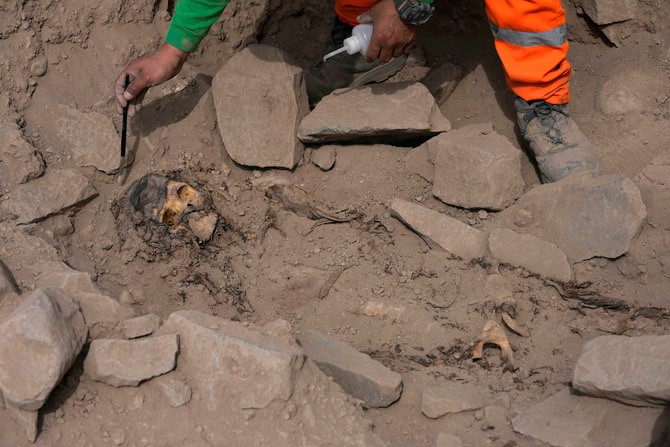LIMA, Peru – Archaeologists discovered a pre-Hispanic mummies surrounded by coca leaves on top of a hill in Peru’s capital, adjacent to a professional soccer club’s practice field.
The Associated Press team saw the skeleton with long black hair laying face up and its lower extremities tied with a rope braided from vegetable vines on Thursday. Stones encircled the mummy, which was buried one meter (three feet) underneath.
The mummy was buried in a ritual that included coca leaves and seashells, according to Miguel Aguilar, an archaeology professor at Universidad Nacional Mayor de San Marcos.
The burial took place on top of a demolished U-shaped clay temple, which was typical of several pre-Hispanic structures. According to Aguilar, the mummy has not yet been radiocarbon dated to ascertain its age.
He stated that ancient fly eggs were discovered adjacent to the male skeleton, prompting them to conclude that the body had been exposed for at least several days before being buried with earth.
It was discovered in Rmac, a region separated from Lima’s historic center by the same-named river. Aguilar is also the director of the Rmac Municipal Historical and Cultural Center.
Pieter Van Dalen, a professor at Universidad Nacional Mayor de San Marcos and an expert on Peruvian coast archaeology who was not involved in the project, said the rope binding the mummy’s lower extremities is an example of the pattern observed in ceremonies. He mentioned another mummy discovered in another part of Lima whose body was likewise tied with vegetable ropes.
The excavators spent the first few months of this year gathering up to eight tons of garbage that had accumulated on the top of the hill, which is adjacent to the Sporting Cristal soccer club’s training field and headquarters. Police also evicted homeless and drug addicts who were camped out around the hill.
The hill, which still preserves the vestiges of ancient mud walls, was a “huaca,” which is a Quechua word that means oracle or sacred location. According to the Ministry of Culture, Lima has about 400 huacas.
Mummies and other pre-Hispanic remains have been discovered in strange locations across the city. Mummies, often children, have been discovered inside big clay containers by workers installing natural gas lines or water mains.
There have also been incidents of people making discoveries, such as Hipólito Tica, who discovered three pre-Hispanic mummies in a hole in his patio. He kept silent about them for a quarter-century, until archaeologists with approval from Peru’s Ministry of Culture removed them in 2022.
Source: AP


